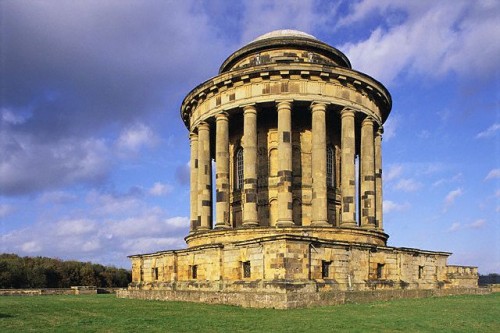
Most people think of a memorial as a sole-purpose ‘something’, there to do exactly what the shot-blast lettering says it’s there to do. A headstone, for example.
Headstones are self-absorbed, stand-alone symbols. They add nothing to their surrounding headstones, neither do they detract from them. They do not beautify the landscape; they may uglify it. They are contextualised only by their massed-ness in an area decommissioned and set aside for the burial of the dead.
A memorial doesn’t have to be such. It can be architectural, like the mausoleum at Castle Howard, above. It can take its place in what James Leedam likes to call ‘the vernacular landscape’, so it can be an obelisk, a shrine, a tree, a cairn. Or a bunch of flowers at the roadside.
We are not confined to just one memorial, either. We can, both, mark the spot where the dead person lies and also keep the memory alive at another location or in other ways, privately or publicly. When I was writing the GFG I came up with: “A memorial can also be a folly, a charitable trust, a web page, a campaign, a horse-race, a half-marathon or a drop-in centre.”
My list was far from exhaustive. For, as Pat McNally made me aware in his post the other day about the Memo Project, “Public memorials can take the form of libraries, concert halls, schools, endowments, and even airports and battleships.” He makes reference also to heroic equestrian statues which “interest pigeons more than people”, and to memorials to the many, not just the one: the Vietnam Memorial, the Holocaust Memorial.
Reading Pat’s post I wondered what we’d missed, what’s new, what’d be appropriate and what wouldn’t.
Veuve Cliquot champagne commemorates Barbe-Nicole Ponsardin very aptly. So the world of food and drink offers opportunities for memorialisation – though it’s unlikely that this could be appropriately accomplished by a new pasta sauce.
What else? What memorialisation opportunity can you think of? What have we missed? Think, think, think! Then hit the comments’ box below.
Thank you!


A street. A city. A rose. A star. Erm…
Thank you, Charles! Any more for any more?
I like to think of the end of the universe as the most magnificent, ego-effacing, equalizing monument to all that is, all who are, all that can be, as we dissolve into the non-existence from whence we, it, he, she, they came.
And call me romantic, but isn’t there a poetic beauty in the knowledge that there will be no individual consciousness to perceive our Grand Finale, nought to remember our nonbeing after the end of time, not even a Little Whimper to echo the Big Bang.
Although, I suppose, technology could bring about the end of the universe before its natural time; ringside seats would have to be prohibitively expensive to cover the investment, mind you. Would it be worth it?
A new species, a new flower variety, are splendid, but we’ve already had them. A racehorse (“he always was a chancer..”)because most graves are left untended after ten years, and a horse would last as long; Irish traditional tunes are often named after musicians (“Tommy People’s” etc) – not always those who devised them (“Miss Walker’s Favourite”)- and it would be lovely to be a tune that got played by seven people in a crowded Galway bar – you could commission one from a musician and ask them to play it sometimes; and of course an occasional and special brew at the local brewery.
I have my wife’s signature tattooed on my bum. Does that count?
no
Charles, I haven’t got the time at all for this but a topic so relevent to my interests, can I resist?
To approach it ex-negativo – one thing that disqualifies a memorial IMHO is that it is too ephemeral. To have any cultural or deeper spiritual sense, a memorial should outlive the lifetime of the first few generations of survivors – it is those who didn’t directly know the deceased who need a reminder that he, like so many other unique individuals, was once also there. Only in this way can the humus of human culture form. Human culture is based on the past, or rather on building on the past, through roots. And these roots are dug in the soil created by memorials – but these memorials have to last a while to allow a layer of cultural topsoil to develop.
This cultural aspect of memorialization, admittedly a subtle one, is totally overlooked in our world which is exclusively forward-thinking and entirely without historical feeling. Without a past, we are doomed to wander in circles – and grow nothing more splendid than weeds. The past is fixed through lasting memorials. I would almost say, in contrast to many of you, that the best memorial is still one in stone.
A website, an online memorial, is almost the antithesis of a true memorial, for there is nothing less perpetual than electricity.
Notice that when people choose a tree as a memorial it is the species that live longest, the venerable old oak for example, that is most desired.
Thomas